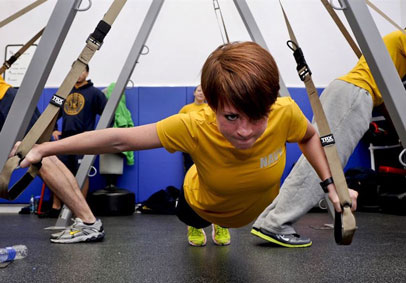Functional fitness training is physical training that’s structured to match the requirements of your everyday tasks. It’s commonly associated with high-intensity interval training (HIIT) and lifting weights overhead. When you consider starting a functional fitness routine, think about what you do every day. Do you lift and move heavy objects, stand or walk in a small area, or sit at a desk for the majority of your day?
Thinking about your job requirements, does your Service have a job-specific physical fitness test? Even if you aren’t required to take a test, looking into the requirements to pass is a good way to start planning your training program. If you don’t have a job-specific test, think about what you do on an average day and what might make your job easier on your body. No matter what your job is, structure a program to work on all components of physical fitness, tweaking the components you spend more time on.
Muscular strength and endurance
For more physically demanding jobs, you’ll want to maintain and improve your muscular strength and endurance. If you have to pick up and carry heavy weights, lift objects overhead, or push objects, HPRC’s foundational movement series can help you train to match your job functions. Structure your training program to match your day-to-day job activities, working primarily to target the muscle groups you use most. While this might sound challenging, you don’t need expert knowledge in anatomy to figure it out. Think about which actions you do during the day, and do similar ones with weights in the gym. Then use the guidelines to improving muscular strength to progress your workouts over a few weeks.
Core stability
No matter how strenuous your job is, it’s important to maintain a high level of both static and dynamic core stability. Static stability is your ability to hold a position when you’re not moving—keeping good posture while sitting, for example. Dynamic stability is your ability to hold a position while you’re moving, such as keeping proper form when squatting, lifting, and moving objects. Improving both types of core stability will not only make the tasks a little easier on your body, but it can also help prevent injuries and other issues like back pain.
If your job is less demanding, focus on your static core stability for proper posture throughout the day. Desk workers are prone to developing neck and back pain from sitting all day, often because they slouch and rest in what feels like a more comfortable position, or because their workspaces are not set up to encourage proper posture. If you “drive a desk,” there’s a good chance you spend more time sitting than you do on your feet. That means you’ll have to work hard during your “on-feet” times to build your core stability and endurance so you can hold your posture when you’re sitting.
The same idea applies to nontraditional desk workers, such as aircrews. Even though you aren’t sitting at a desk, you’re still in a sitting position for long periods of time. Add in tight seating conditions, whole-body vibration, and high-Gs, and you’re now an elite sitter. While you might not spend more time in your aircraft than you do outside, these sitting conditions are worse than at a desk, especially if you’re too tall for your airframe. Much like a traditional desk worker, you’ll also have to work hard in your “on-feet” times to offset the negative effects from sitting.
“On-feet” time
On-feet time is any time not spent sitting for work or relaxation. It includes standing, exercising, walking, or any other activity. At least 30 minutes of your on-feet time should be spent exercising every day, ideally structured to combat the negative effects of your job. So for the sitters, both elite and non-elite alike, make time to work on static and dynamic core stability to maintain a good sitting position. You also want to get in at least 30 minutes of cardio each day. Sitting for at least 8 hours a day—common for a desk worker—can have severe negative health effects—including a higher risk of early death (before age 80). The only way to offset this is to get at least 150 minutes of moderate-intensity physical activity every week during your on-feet times.
High-intensity interval training
HIIT is often called functional training, especially when it’s run by commercial gyms. While this type of physical training might be functional for some, it’s not truly functional for everyone. Yet even if HIIT doesn’t match what you do day-to-day, you don’t need to scrap it for a lower-intensity workout. Just remember to build exercises into your routine to improve static core stability so you can have good posture while sitting or doing a less demanding job.
